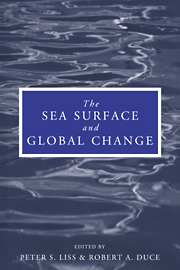Book contents
- Frontmatter
- Contents
- List of contributors
- Preface
- 1 Report Group 1 – Physical processes in the microlayer and the air–sea exchange of trace gases
- 2 Report Group 2 – Biological effects of chemical and radiative change in the sea surface
- 3 Report Group 3 – Photochemistry in the sea-surface microlayer
- 4 Transport processes in the sea-surface microlayer
- 5 The role of organic films in air–sea gas exchange
- 6 Bubbles and their role in gas exchange
- 7 The physical chemistry of air–sea gas exchange
- 8 The sea-surface microlayer and its effect on global air–sea gas transfer
- 9 Chemistry of the sea-surface microlayer
- 10 Biophysics of the surface film of aquatic ecosystems
- 11 Biological effects of chemicals in the sea-surface microlayer
- 12 Neuston of seas and oceans
- 13 Photochemistry in the sea-surface microlayer
- 14 Hydrocarbon breakdown in the sea-surface microlayer
- 15 Applications of laser technology and laser spectroscopy in studies of the ocean microlayer
- 16 Remote sensing of the sea-surface microlayer
- Index
14 - Hydrocarbon breakdown in the sea-surface microlayer
Published online by Cambridge University Press: 24 September 2009
- Frontmatter
- Contents
- List of contributors
- Preface
- 1 Report Group 1 – Physical processes in the microlayer and the air–sea exchange of trace gases
- 2 Report Group 2 – Biological effects of chemical and radiative change in the sea surface
- 3 Report Group 3 – Photochemistry in the sea-surface microlayer
- 4 Transport processes in the sea-surface microlayer
- 5 The role of organic films in air–sea gas exchange
- 6 Bubbles and their role in gas exchange
- 7 The physical chemistry of air–sea gas exchange
- 8 The sea-surface microlayer and its effect on global air–sea gas transfer
- 9 Chemistry of the sea-surface microlayer
- 10 Biophysics of the surface film of aquatic ecosystems
- 11 Biological effects of chemicals in the sea-surface microlayer
- 12 Neuston of seas and oceans
- 13 Photochemistry in the sea-surface microlayer
- 14 Hydrocarbon breakdown in the sea-surface microlayer
- 15 Applications of laser technology and laser spectroscopy in studies of the ocean microlayer
- 16 Remote sensing of the sea-surface microlayer
- Index
Summary
Abstract
Hydrocarbons, being minor constituents of dissolved organic matter in seawater, under normal conditions make up a small fraction of the organic surface film. In spill situations, however, they can become principal constituents. Depending on chemical structure, availability of nutrients, enrichment of microorganisms, and light regime, hydrocarbons in the surface microlayer are decomposed either microbially or photochemically. As most biogenic and the majority of fossil hydrocarbons are transparent to solar UV radiation at sea level, sensitizers are required for their photochemical oxidation and decomposition. Sensitizers include natural products, such as humic material, and anthropogenic compounds, such as polycyclic aromatic ketones. Photochemical decomposition products of hydrocarbons include alcohols, aldehydes, ketones, and terminal alkenes. Generation of low-molecular-weight carbonyl compounds by photochemical carbon chain fragmentation has been observed. Microbial decomposition of photooxidation products is often faster than that of the parent hydrocarbons.
Microlayer samplers
The term ‘sea-surface microlayer’ has been defined operationally as that thin layer of water adjacent to and including the air–sea interface which adheres to sampling devices such as wiremesh screens, glass plates, Teflon discs, rotating drums, or collectors for the spray generated by bursting bubbles (Liss, 1975, and references cited therein). Van Vleet and Williams (1980) found preferential uptake of different compound classes to depend upon the type of sampler and the material it is made of (see also Daumas et al., 1976).
- Type
- Chapter
- Information
- The Sea Surface and Global Change , pp. 425 - 444Publisher: Cambridge University PressPrint publication year: 1997
- 1
- Cited by



